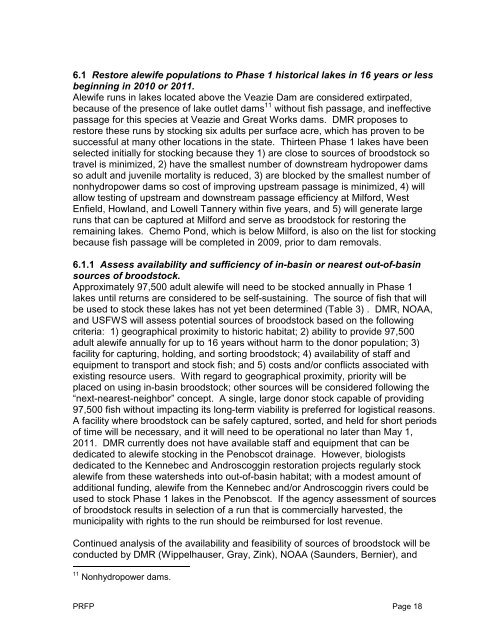Operational Plan for the Restoration of Diadromous Fishes to the ...
Operational Plan for the Restoration of Diadromous Fishes to the ...
Operational Plan for the Restoration of Diadromous Fishes to the ...
Create successful ePaper yourself
Turn your PDF publications into a flip-book with our unique Google optimized e-Paper software.
6.1 Res<strong>to</strong>re alewife populations <strong>to</strong> Phase 1 his<strong>to</strong>rical lakes in 16 years or less<br />
beginning in 2010 or 2011.<br />
Alewife runs in lakes located above <strong>the</strong> Veazie Dam are considered extirpated,<br />
because <strong>of</strong> <strong>the</strong> presence <strong>of</strong> lake outlet dams 11 without fish passage, and ineffective<br />
passage <strong>for</strong> this species at Veazie and Great Works dams. DMR proposes <strong>to</strong><br />
res<strong>to</strong>re <strong>the</strong>se runs by s<strong>to</strong>cking six adults per surface acre, which has proven <strong>to</strong> be<br />
successful at many o<strong>the</strong>r locations in <strong>the</strong> state. Thirteen Phase 1 lakes have been<br />
selected initially <strong>for</strong> s<strong>to</strong>cking because <strong>the</strong>y 1) are close <strong>to</strong> sources <strong>of</strong> broods<strong>to</strong>ck so<br />
travel is minimized, 2) have <strong>the</strong> smallest number <strong>of</strong> downstream hydropower dams<br />
so adult and juvenile mortality is reduced, 3) are blocked by <strong>the</strong> smallest number <strong>of</strong><br />
nonhydropower dams so cost <strong>of</strong> improving upstream passage is minimized, 4) will<br />
allow testing <strong>of</strong> upstream and downstream passage efficiency at Mil<strong>for</strong>d, West<br />
Enfield, Howland, and Lowell Tannery within five years, and 5) will generate large<br />
runs that can be captured at Mil<strong>for</strong>d and serve as broods<strong>to</strong>ck <strong>for</strong> res<strong>to</strong>ring <strong>the</strong><br />
remaining lakes. Chemo Pond, which is below Mil<strong>for</strong>d, is also on <strong>the</strong> list <strong>for</strong> s<strong>to</strong>cking<br />
because fish passage will be completed in 2009, prior <strong>to</strong> dam removals.<br />
6.1.1 Assess availability and sufficiency <strong>of</strong> in-basin or nearest out-<strong>of</strong>-basin<br />
sources <strong>of</strong> broods<strong>to</strong>ck.<br />
Approximately 97,500 adult alewife will need <strong>to</strong> be s<strong>to</strong>cked annually in Phase 1<br />
lakes until returns are considered <strong>to</strong> be self-sustaining. The source <strong>of</strong> fish that will<br />
be used <strong>to</strong> s<strong>to</strong>ck <strong>the</strong>se lakes has not yet been determined (Table 3) . DMR, NOAA,<br />
and USFWS will assess potential sources <strong>of</strong> broods<strong>to</strong>ck based on <strong>the</strong> following<br />
criteria: 1) geographical proximity <strong>to</strong> his<strong>to</strong>ric habitat; 2) ability <strong>to</strong> provide 97,500<br />
adult alewife annually <strong>for</strong> up <strong>to</strong> 16 years without harm <strong>to</strong> <strong>the</strong> donor population; 3)<br />
facility <strong>for</strong> capturing, holding, and sorting broods<strong>to</strong>ck; 4) availability <strong>of</strong> staff and<br />
equipment <strong>to</strong> transport and s<strong>to</strong>ck fish; and 5) costs and/or conflicts associated with<br />
existing resource users. With regard <strong>to</strong> geographical proximity, priority will be<br />
placed on using in-basin broods<strong>to</strong>ck; o<strong>the</strong>r sources will be considered following <strong>the</strong><br />
“next-nearest-neighbor” concept. A single, large donor s<strong>to</strong>ck capable <strong>of</strong> providing<br />
97,500 fish without impacting its long-term viability is preferred <strong>for</strong> logistical reasons.<br />
A facility where broods<strong>to</strong>ck can be safely captured, sorted, and held <strong>for</strong> short periods<br />
<strong>of</strong> time will be necessary, and it will need <strong>to</strong> be operational no later than May 1,<br />
2011. DMR currently does not have available staff and equipment that can be<br />
dedicated <strong>to</strong> alewife s<strong>to</strong>cking in <strong>the</strong> Penobscot drainage. However, biologists<br />
dedicated <strong>to</strong> <strong>the</strong> Kennebec and Androscoggin res<strong>to</strong>ration projects regularly s<strong>to</strong>ck<br />
alewife from <strong>the</strong>se watersheds in<strong>to</strong> out-<strong>of</strong>-basin habitat; with a modest amount <strong>of</strong><br />
additional funding, alewife from <strong>the</strong> Kennebec and/or Androscoggin rivers could be<br />
used <strong>to</strong> s<strong>to</strong>ck Phase 1 lakes in <strong>the</strong> Penobscot. If <strong>the</strong> agency assessment <strong>of</strong> sources<br />
<strong>of</strong> broods<strong>to</strong>ck results in selection <strong>of</strong> a run that is commercially harvested, <strong>the</strong><br />
municipality with rights <strong>to</strong> <strong>the</strong> run should be reimbursed <strong>for</strong> lost revenue.<br />
Continued analysis <strong>of</strong> <strong>the</strong> availability and feasibility <strong>of</strong> sources <strong>of</strong> broods<strong>to</strong>ck will be<br />
conducted by DMR (Wippelhauser, Gray, Zink), NOAA (Saunders, Bernier), and<br />
11 Nonhydropower dams.<br />
PRFP Page 18






